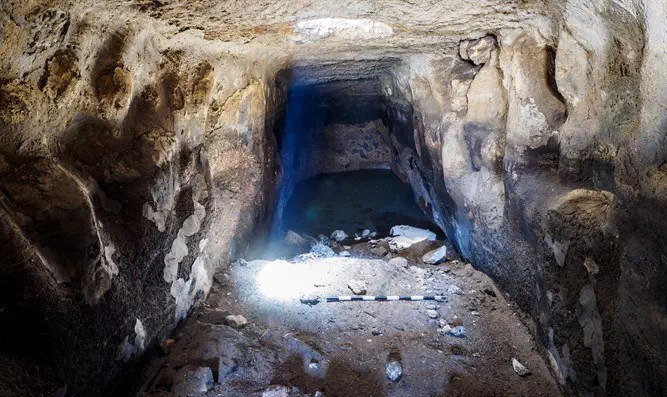by Arutz Sheva Staff
Major water network from 1st Temple era found in central Israel. System suggests Kingdom of Israel was not desolate after Assyrian conquest.

View from inside the water system
Assaf Peretz/Israel Antiques Authority
The excavation was initiated ahead of a planned building project for the construction of a new residential neighborhood in Rosh Haayin.
According to Gilad Itach, director of excavations for the IAA, “It is difficult not to be impressed by the sight of the immense underground reservoir quarried out so many years ago. In antiquity, rainwater collection and storage was a fundamental necessity. With an annual rainfall of 500 mm, the region’s winter rains would easily have filled the huge reservoir. On its walls, near the entrance, we identified engravings of human figures, crosses, and a vegetal motif that were probably carved by passersby in a later period. Overall, we identified seven figures measuring 15–30 cm. Most have outstretched arms and a few appear to be holding some kind of object.”
The water system exposed is nearly 20 meters (66 feet) long and reaches a depth of over 4 meters (13 feet).
The excavations reveal that the reservoir was built beneath a large structure with walls that are all nearly 50 meters (164 feet) long. Some of the potsherds found on the floors of the rooms probably belonged to vessels used to draw water from the reservoir. It is highly likely that the structure and the reservoir were built at the end of the Iron Age (late eighth or early seventh century BCE), but whereas the building was abandoned during the Persian period the reservoir was still in use until modern times.
In recent years, a number of other farmsteads built at the end of the First Temple period have been discovered near Rosh Haayin. They were probably erected after the destruction of the northern Kingdom of Israel in 720 BCE, when the Assyrian empire dominated the region. The establishment of farmhouses in this area is interesting, given the fact that many regions within the decimated Kingdom of Israel remained desolate.
Some scholars believe that the establishment of the farmsteads was motivated by the empire’s wish to settle the area, which lay on an international route and near the western border of the Assyrian empire.
According to Itach, “The structure exposed in this excavation is different from most of the previously discovered farmsteads. Its orderly plan, vast area, strong walls, and the impressive water reservoir hewn beneath it suggest that the site was administrative in nature and it may well have controlled the surrounding farmsteads.”
Arutz Sheva Staff
Source: http://www.israelnationalnews.com/News/News.aspx/232744
Follow Middle East and Terrorism on Twitter
Copyright - Original materials copyright (c) by the authors.
1 comment:
Would like to see this discussed in the light of Cana'an being re-named Palestine by record keepers.
Post a Comment